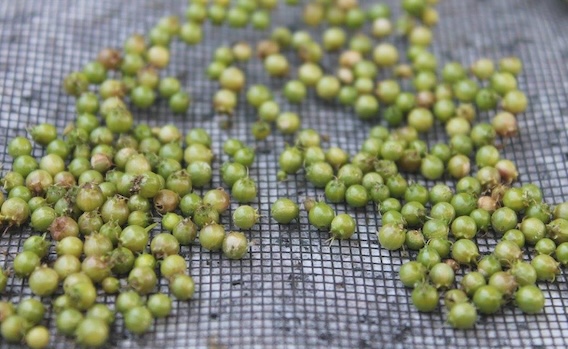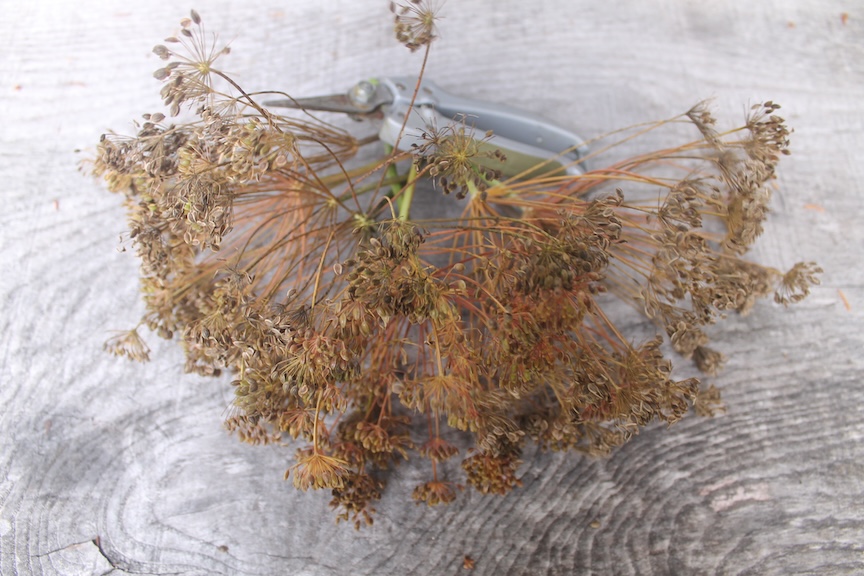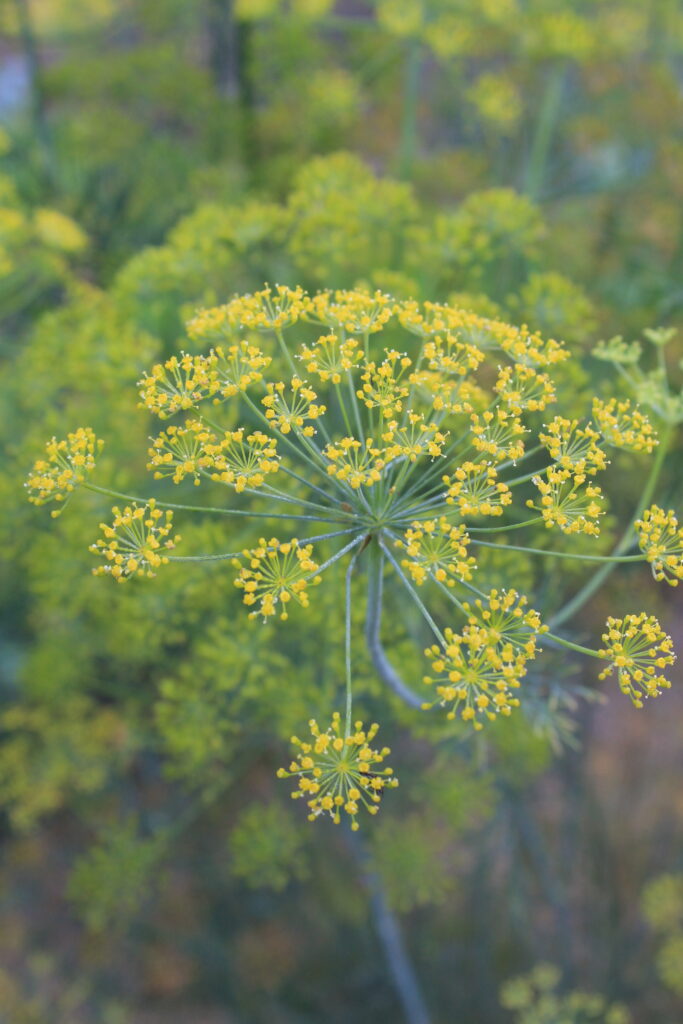By Will Bonsall
Spices have always held a peripheral importance in virtually all cuisines, despite their relatively low nutritional value. They’re especially significant in diets based on bland foods like rice and potatoes, whose nutrient value itself is not enough to stimulate the appetite.
To be clear, I’m distinguishing spices from leafy herbs, most of which are easy to grow in Maine, whereas the tropical spices are not. I often think of those spices as “conflict foods,” sort of like conflict metals, which because of their rare occurrence and strategic uses often weigh disproportionately (and negatively) in foreign affairs. Items like cinnamon, pepper, nutmeg, coffee and cacao have historically been incentives for wars of imperial expansion. Some of those tropical spices can be replaced by spices we can grow.

Several of these Maine-friendly spices, such as coriander, dill, caraway and cumin, are in the carrot family (Apiaceae). It’s no coincidence that they’re all rich in various aromatic oils and terpenes that add interest to our staples. Beyond those, mustard seed, cayenne and fenugreek add a pungent accent to curries and other savory dishes. Let’s hit all those in turn.
I find coriander exceptionally easy to grow. I seed it in the center rows of my onion beds, three rows of onions on either side, sown at the same time, as coriander is quite cold-hardy. Indeed, I often have it come up from last year’s shattered seed, and since I rotate my beds, it will be a weed (albeit easily dispatched) in the new crop. I direct seed in shallow furrows like I do for carrots and eventually thin to 4-10 inches between plants, 8-12 inches between rows, whether onions or coriander. I treat dill in just the same way.
Cumin, another annual, is not so easy to grow here, as it prefers a longer, warmer season. I’ve experimented with starting it in seedling trays — 50 or 72 cells, thinned to three plants each — and setting those starts out as clumps when frost danger has passed. Cumin is more cold-sensitive than coriander.
Anise and fennel seed are grown in much the same way. I find them harder to bring to maturity unless pre-sown like cumin.
Caraway is easily grown, but it’s a hardy biennial, so I must direct seed the plot the first year and let them overwinter (a thin mulch helps) to go to seed the second year.
Now all of these species form an umbel-shaped seed head (think Queen Anne’s lace or feral carrot), which should be left until ripe and thoroughly dry. I strip off the seed heads, taking care not to shatter them. I may do this by clipping the plants early in the morning while a tad dewy, then letting them re-dry in a loose paper bag. When dry, the seeds are easily rubbed off from their umbels. Unfortunately, a lot of the little “stemlets” may come off, too, and must be removed. Once I’ve blown away the lighter dust, I use a colander to sift out many of the stems. If the holes are just right in size, the seed will pass right through, leaving the stemmy bits in the colander. I find coriander especially easy to clean, as the round seeds will roll down a slope, leaving the debris behind. Tom Stearns of High Mowing Seeds came up with a fiendishly clever funky-tech piece of equipment for this. Take a piece of corrugated cardboard and roughen it in one direction with coarse sandpaper. This will create a velvety surface suitable for an Elvis painting, or for shaking down partially cleaned seed. After a while the surface may get all clogged up with seed dust but, hey, replacement cost is quite minimal. By the way, this also works very well for white mustard seed.

While caraway is often used whole, in my experience cumin and coriander are best ground to release the flavor. However, grinding too long before use will allow much of the essential oils to evaporate, which is why store-bought spices often lack the rich flavor of those freshly ground. My friend Yaicha Cowell insists (and I agree) that the fullest aroma and taste is achieved by lightly toasting the whole seed in a cast iron pan and grinding just before using.
However, grinding small quantities of seed for immediate use can be wasteful. I grind spices in my Corona grain mill (as well as dried garlic, paprika and sunchokes), though others may get satisfactory results with a blender or coffee grinder, and some spices will remain in the chamber. Unless you want whatever you grind next to have that flavor (coriander in your coffee? cayenne in your oatmeal?) you’ll want to flush it out with something bland (like cornmeal). You can minimize waste by grinding a large amount at a time, but I’ve just explained the problem with that …
Back to the garden: I like to companion ferny-leafed crops with leafier vegetables since the lighter-foliage canopy of those carrot relatives allows sunlight to reach the ground, encouraging weed growth.

Other than the carrot family spices, I like to grow my own yellow mustard (especially for any pea dishes). I plant in rows 12 inches apart (three rows in my 52-inch beds), alternating with two rows of some short unrelated crop (like chard or beets but not radish). Because they’re susceptible to flea beetles, I often spray mustard (like any other Brassica) with a rhubarb leaf extract for the first week or two. Mustard is a short-season crop, so the planting can be succeeded by lettuce, endive or scallions, while the beets/chard just keep growing. Moreover, planting beets/chard with mustard will greatly reduce infestations of beet nematode.
Another spice I’ve grown with some success is fenugreek. It seems most folks associate this pungent legume spice with curry powder, and rightly so, but many do not realize that the seed, roasted and ground, is also the active flavoring ingredient in artificial maple syrup. It is most commonly grown in the South, where it is often used as a soil-building crop, though I have grown it in Maine. The saber-shaped seedpods are somewhat prone to shatter, so care must be taken to harvest them as they ripen.
Years ago, I experimented with shepherd’s purse as an alternative to black pepper. It is super easy to grow here and can easily become a weed, albeit easily removed. It is said to attract and kill nematodes; however, since some nematodes are beneficial this may be a mixed benefit. One alleged problem (or benefit?) with shepherd’s purse is that it encourages blood clotting at wounds. Thus, it is sometimes used to staunch postpartum hemorrhaging. I’m assuming that at the rate it is used as a spice such benefits or problems are negligible. I only know I used it occasionally for years without noticing any health issues. And, after all, black pepper carries its own set of health concerns.
I suppose horseradish might be considered a spice, or at least a condiment, although it is not often used in dried or powdered form. As a very hardy perennial, it is easy to grow and prepare: grated, ground or salted into a pungent sauce.
Hot or red pepper (Capsicum annuum) is another spice that is easily grown in Maine gardens. The trick is creating a fine powder, such as is usually called for in dishes like chili. One can of course make an infusion for a “hot sauce” or crush the dried pods into flakes, but let’s say you want powdered cayenne — or paprika, which is essentially the same, only milder. It’s fairly easy to grind very dry crushed pods in a Corona grain mill, but the spicy oil will leave a residue on chamber and plates, requiring a major clean-out before grinding anything else. If one sets the plates too tightly, they may get hopelessly varnished with a gummy residue that requires elbow grease to remove (and may result in burning fingers). That’s why I specify “crushed” pods: the breakup is already partly done. By adjusting the plates to a slightly looser setting, one can also avoid that buildup on the plates while resulting in a reasonably fine powder. It’s all a matter of tweaking. If you grind a large quantity at a time — say, the whole crop — then you avoid the waste compared to if you flushed the mill after every use. Unlike the carrot family spices mentioned earlier, the essential principle (capsicum oil) is more stable and less volatile.
About the author: Will Bonsall lives in Industry, Maine, where he directs Scatterseed Project, a seed-saving enterprise. He is the author of “Will Bonsall’s Essential Guide to Radical Self-Reliant Gardening” (Chelsea Green, 2015). And indeed, he is also a distant cousin of another exemplary Maine horticulturist: Tom Vigue. You can contact Bonsall at [email protected].
This article was originally published in the summer 2024 issue of The Maine Organic Farmer & Gardener. Looking for more gardening resources? Browse the archives and consider signing up for our monthly gardener newsletter.
